Bass pedals are electronic units, designed for sound processing of electric bass guitars. The best bass pedals are able to enhance the guitar’s sound and add some effects to it, changing the overall sounding in drastic, experimental ways with just a few tweaks.
Any guitarist aspires to make his or her instrument sound better, or at the very least, more unique and distinctive. Some bass pedals create a smooth tone, the others make it loud and even crazy. Other models even can shape the tone without a bass amplifier. This way, the bass players of all levels and backgrounds (from hard-core to jazz) can benefit from buying one or several bass pedals.
The bass pedals can include one or several effects. The singular-function bass pedal poses only one effect. The quality of this single effect is usually slightly higher than the quality of effects in the composition of the multifunctional pedal.
Some pedals combine several effects in one unit. They are perfect for musicians that want to use various effects, and their combinations. It also allows saving a lot of space on your pedalboard as you are using one pedal with several effects instead of several pedals with one effect.
The bass pedals come in a variety of shapes and sizes, offer different functionality. Someone may like to go for a straight-to-the-point pedal. The others want a pedal that houses a number of controls. Keep on reading our article to learn about our top 9 picks and choose the model you need by weighting their main pros and cons.
Bass Pedal Reviews
BOSS TU-3
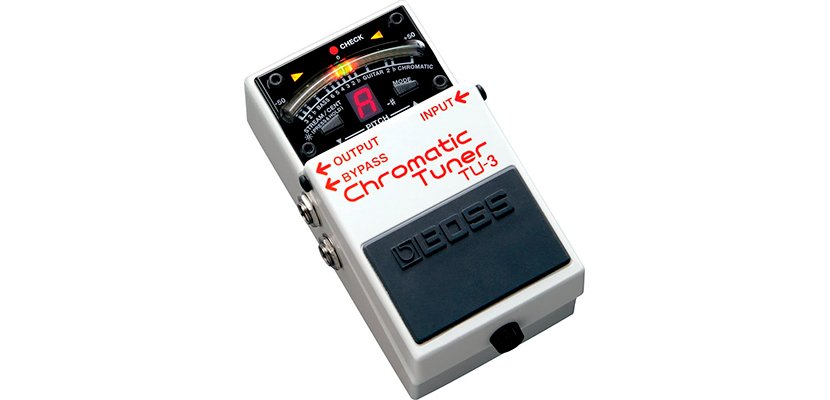
The TU-3 is an updated version of the legendary classic BOSS 1998. It’s a tuner pedal with chromatic guitar/bass modes. As most of BOSS bass pedals, the unit has a tank-tough housing. Just like all the pedals from the TU series, the TU-3 is conceived as roadworthy and accurate supporting 6-string and 7-string guitars.
The tuning is performed by string number. The bass guitar notes are shown with a handy note name indication. With the Guitar Flat mode, you can tune up to 6 semitones which is especially important for bassists that play heavy music.
The high-brightness 21-segment LED meter allows tuning the tone in the most precise way. so you can adjust it to the maximum for outdoor use, or dim it when playing in well-lit conditions. There is also an AccuPitch confirmation display which informs you when tuning is complete in glowing green.
There is no real bypass switching, which may be a problem for people who need the purest tone possible. However, the bypass output helps when you use long cords and numerous pedals. It also cuts the signal so you can tune in silence.
Being a tuner pedal, the TU-3 is one of the best bass pedals for on-stage performing as it can assist you in situations when your bass goes out of tune.
This bass pedal doesn’t offer wide functionality and is mainly designed for those players that just need an accurate tuning. It measures 4 x 3 x 6 inches and weighs slightly more than one pound.
Pros
- The pedal automatically mutes when the tuner is on.
- TU-3 can supply power to 7 compact BOSS pedals.
- Reliability is ensured with a 5-year guarantee.
Cons
- The display is pretty small, so you have to bend over to see figures.
- The pedal uses power until you unplug the cable.
Video BOSS TU-3
Vox StompLab 2B

The reviewed model released by the Vox company is worth claiming the title of the best bass multi-effects pedal as well. This is a modeling red metal bass guitar pedal that uses a sound engine from the Vox’s VT+ series amplifiers.
One of the greatest things about this pedal is a wide array of different tunes that it’s able to offer. 61 types of different effects will allow you to model the sound in drastic ways. There are also 100 presets that are conveniently categorized according to music styles such as rock, pop, jazz/fusion, funk, heavy metal, and dance. This makes it quicker to select the desired sound. Each category also has 10 variations, so you will surely reach the sounds you like.
This way, this multi-effects pedal can offer a lot of sounds that range from distorted to clean ones. While having so many sounds and effects is a huge advantage, it may also be confusing and challenging for novices.
Being one of the multifunctional bass effects pedals, the StompLab 2B includes two control knobs: Gain and Level. Besides, there is also an expression pedal, located on the right part of the unit. The expression button sets the function (volume, wah, effect parameters) of the expression pedal. The digital display, depending on the mode, indicates the selected program number, knob value, name of the note that you are tuning, the effect abbreviations, and parameter values.
The Vox StompLab 2B uses an AA battery or can be powered via an AC adapter. There are one standard audio input and output/phones jack for bass amp, mixer, recorder, or headphones. The unit’s size is 9 x 3 x 7 inches and weighs 1.3 pounds.
Pros
- You can save and edit up to 20 your own presets.
- Up to 8 effects can be used simultaneously.
- The battery lasts for 7.5 hours on one charge.
Cons
- The user’s manual doesn’t specify what 100 presets do.
- It’s not easy to find out what various display abbreviations mean.
Video Vox StompLab 2B
Fender Downtown Express

This bass EQ pedal from Fender incorporates 3 of the most widely used effects for tone-shaping — compressor, overdrive, and EQ with a full suite of controls for each effect. This 3-in-one unit is made of aluminum and has a nice-looking metallic finish.
This model is a bass multi-effects pedal as each effect’s section has its own 3 control knobs.
The Overdrive section of the unit has Level, Tone, and Bass controls. The Compressor section incorporates Blend, Gain, and Threshold knobs. The Equalizer section includes Bass, Middle, and Treble controls.
The Master Volume control knob is responsible for the overall volume level control. With the Order toggle, you can set the order of your effects. For example, you may put a compressor in front of your overdrive, and vise versa.
This pedal’s top panel has a Mute footswitch at the bottom that prevents the bass signal from leaving the inputs. Next to it, there are Equalizer, Overdrive, and Compressor footswitches each of which bypasses their section. Each footswitch has its own on/off indicator.
The input jack works for bass, electric, and acoustic guitars with pickup systems, keyboards, and other instruments. The tuner output lets you keep your tuner active without interrupting the signal path. There are an output jack and direct XLR output.
This bass effects pedal is 7.4 x 4.9 x 2.5 inches in size, weighs 1.2 pounds, and requires a 9V 400 mA power supply.
Pros
- The DI signal path switch lets you decide when your instrument’s signal reaches the XLR output.
- The circuit is completely analog so the tone is more organic.
- All the controls are illuminated with LED light and are clearly seen in the dark.
Cons
- The volume level control isn’t stable.
- The thin metal frame’s chassis lacks sturdiness.
Video Fender Downtown Express
Behringer BOD400
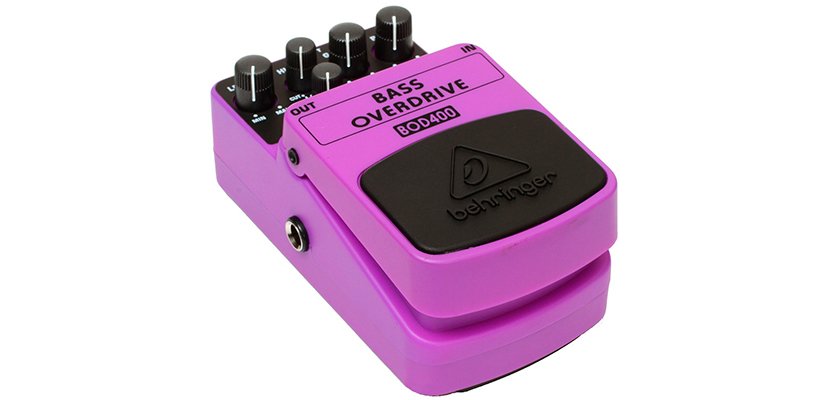
You may want to add this Behringer pedal to your list if you are searching for the best bass overdrive pedal. It’s a tube-like model which is designed for creating different types of distortion, from smooth to crazy, giving you full control over your guitar’s lows. This pedal is made of purple plastic, so it’s clearly not durable. It supports the entire range of bass guitars, even 5-string and 6-string models.
The pedal has 5 controls despite its tiny size (2.76 x 2.13 x 4.84 inches). All of them are clear and easy-to-use for creating distorted effects.
The Level knob adjusts the output level. The High knob allows you to boost/cut the high-frequency range. The Low knob lets you boost/cut the low-frequency range. The Gain knob adjusts the amount of overdrive. The Balance knob is used to mix the signals. There is also a blue LED indicator which shows the effect’s on/off status and also serves as a battery check.
The BOD400 has an input to plug in the instrument’s cable. It weighs 0.7 pounds and requires a 9V battery or 9V DC power supply.
Pros
- The onboard 2-band EQ gives the opportunities for more tone sculpting.
- The pedal works without making any noise thanks to the electronic on/off switch.
- You can expect a very heavy distortion as you increase gain which is a pleasant surprise as for such a small unit.
Cons
- The pedal can’t offer a pure overdrive push.
- There is no true bypass.
- It makes poor-quality pickups sound even worse.
Jim Dunlop MXR
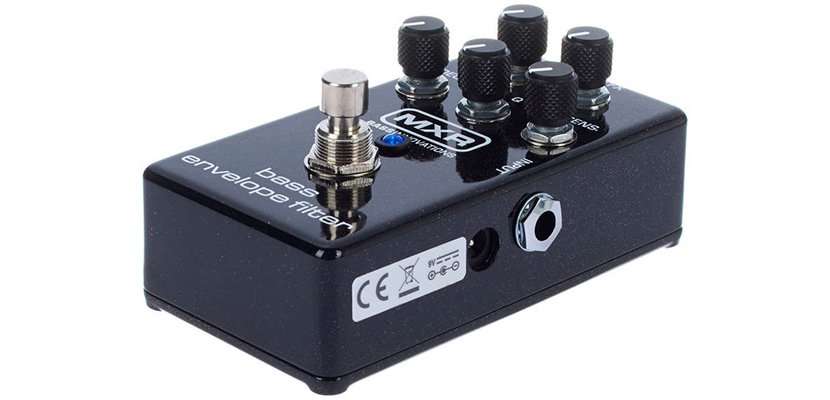
This model from Jim Dunlop is one of the best bass effects pedals for those who want to copy the 70s funk sound. It’s a bass envelope filter pedal and works similar to wah pedals, responding to your string attack, and preserves the guitar’s natural character while adding a wah effect to the signal. Thanks to an all-analog circuitry, the pedal gives out a classic tone. It comes with a sparkling purple aluminum chassis, 5 knobs, and a true bypass footswitch.
All the knobs are divided into two rows. The top row has Dry and FX level controls that are designed for preserving low end which is really important for bass because when the filter rises up, the lower end of the note falls. The Dry knob controls the volume of an unaffected signal. The FX knob controls the volume of the envelope filter signal.
The Decay knob sets envelope filter’s decay stop frequency. The Q knob controls the intensity of the effect. The Sensitivity knob allows controlling the sensitivity level of the filter. The bypass footswitch has brights blue LED indicator which indicates an on/off status.
It may take some time for novices to figure out how to adjust the envelope filter knobs. They are also touch-sensitive and their responsivity depends on the strength of the bass guitar’s output.
The pedal can be powered by one 9V battery or a 9V adapter. It weighs less than one pound (0.84 inches) and measures 2.5 x 4.5 x 5.5 inches, so it’s smaller than many other stompboxes.
Pros
- The user’s manual has 3 sample settings for synth bass, classic funk, and techno/dance.
- The pedals power supply circuitry is able to withstand over-voltage or polarity mishaps.
- There is a Dry/FX blend option.
Cons
- The input jack connection and the power supply input are too near together.
- It lacks control over the filter sweep direction.
Video Jim Dunlop MXR
BOSS GEB-7
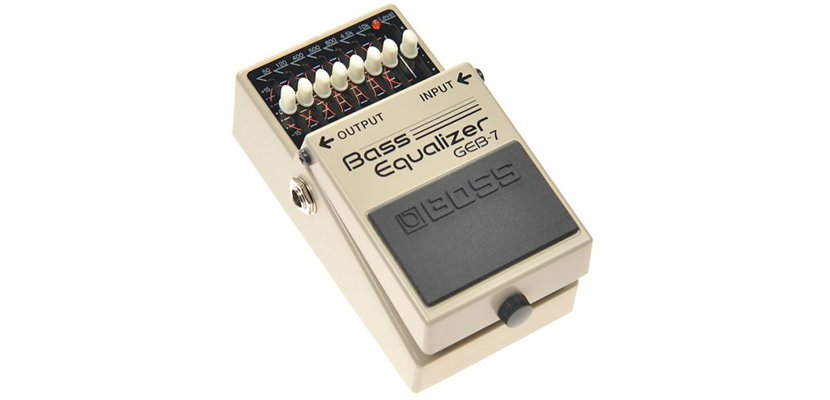
The GEB-7 is a seven-band equalizer, being one of the bass effects pedals designed for the wide frequency range settings of the bass guitar (including even 5-string and 6-string bass guitars). More precisely, this pedal provides an optimum equalizer’s bandwidth. In terms of build quality, the unit has a grey aluminum die-cast body.
The equalizer’s sliders enable you to adjust the center frequency (from 50 to 4.5K or 10kHz within +/-15dB). The Level sliders serve for adjusting the output level of the effect sound to minimize the level distance between original and processed signals. So as you can see, the pedal allows for both delicate tuning and some radical settings. There is also a LED red check indicator to show the on/off status which also works as battery level indicator.
The pedal allows extending the frequency range to 50Hz, so it’s one of the best bass guitar pedals for adjusting the depth and bottom end of your sound.
There are is an output jack to connect the unit to an amplifier or other devices, and a standard input jack for your bass guitar that serves as a power switch. The GEB-7 can be powered via an AC adaptor (only the one from PSA series) or a 9V battery.
With dimensions of 2.7 x 4.9 x 2.1 inches and a weight of one pound, this model is one of the smaller bass guitar pedals.
Pros
- The manufacturer claims that the pedal switch can withstand up to 100,000 repetitions.
- The pedal boasts a non-slip rubber base.
- It can be used with acoustic guitars.
Cons
- It may be noisy when you use any other mains except for the Boss PSA230 power lead.
- It must be placed only at the beginning of the chain for a high-quality effect.
Video BOSS GEB-7
BOSS CEB-3
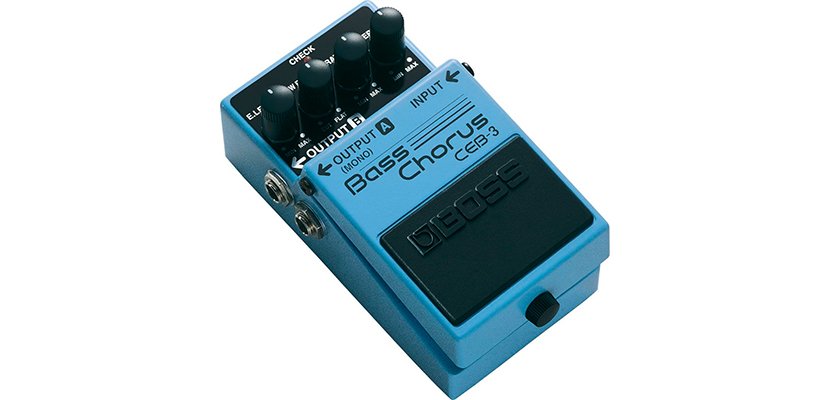
The CEB-3 from BOSS may be the best bass chorus pedal as it splits the high frequencies of your sound, offering you an impressively rich chorus. The pedal contains 4 control knobs and has a blue aluminum casing.
The Effect Level knob allows controlling the level of the effect sound. The Low Filter controls the lows of your bass sound. The Rate and Depth knobs adjust the speed/depth of the effect. The red LED light lets you know whether the battery is turned on.
There are two output jacks: output A (mono, only for processed signal) and output B (only for dry signal). The input jack accepts input signals from your bass guitar.
The CEB-3 adopts the Space synthesis system which means that the depth of the effect varies depending on the distance between the speakers.
Having only 2.8 x 5 x 2.3 inches, the pedal weighs one pound accordingly. You may use an AC adaptor (from the PSA series) or a 9V battery if you don’t want to deal with additional wires.
Pros
- The high-quality digital circuit provides a transparent, smooth sound.
- The power of the bass is retained no matter how you adjust the knobs, so you never lose all the power of the original sound.
- The pedal doesn’t alter lower frequencies.
Cons
- Not a true bypass pedal.
- Since the pedal mainly uses high frequencies, the sound may be too bright.
Video BOSS CEB-3
BOSS BB-1X
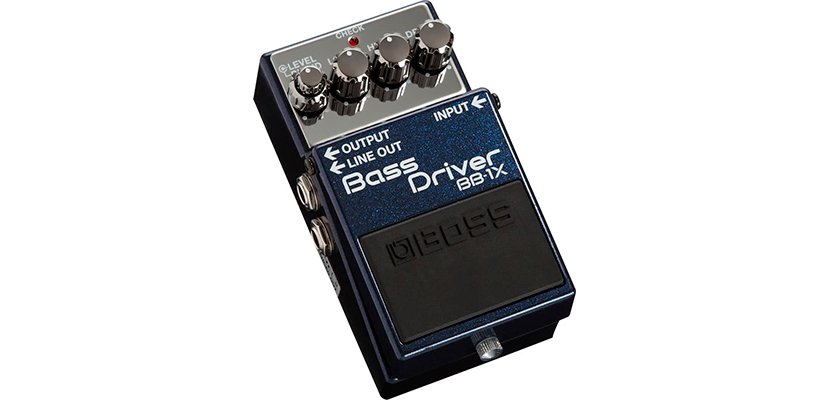
The BOSS BB-1X is a bass distortion pedal with four control knobs. The mirror metal surface on the panel with knobs contrasts with the sparkling blue finish on the remainder of the device.
The first knob in a row combines Blend and Level controls to blend the signals and control the volume level. You can use the Low and High knobs to make your tone thinner or wider. The Drive knob adjusts the amount of overdrive. On the very top of the face screen is a red LED indicator that displays battery and off/on states. The BB-1X can potentially be the best bass distortion pedal since it doesn’t muffle the low end.
Except for standard input jack for the bass instrument, there are two output jacks: one for bass amplifier connection and the other for connection directly to PA or recorder.
This pedal is powered by a BOSS PSA-series AC adapter or 9V battery. Being among the space-saving bass guitar pedals, the BB-1X has 2.8 x 5 x 2.3 inches and weighs one pound.
Pros
- Thanks to the BOSS MDP technology, the BB-1X delivers a wide range of sounds, from natural to heavy ones, being suitable for any playing style.
- The BB-1X can function as a preamp.
- The pedal doesn’t make any noise in the signal.
Cons
- It uses the TRS jack instead of standard XLR.
- The shiny knob panel collects dust and soon becomes filthy.
Video BOSS BB-1X
Caline CP-60

Consider this model from Caline if you are searching for the best bass preamp pedal. It goes in a yellow aluminum case and features 6 control knobs.
The Drive, High, and Low control knobs adjust the volume of frequency. The Volume knob allows controlling the overall volume level. The Harmonics knob adjusts the cabinet emulation circuit. The Mix knob adjusts the amount of reverb. There is also a true bypass with LED light for indicating the bypass status. With this degree of control, the CP-60 is one of the most precise bass guitar effects pedals available.
Except for standard input for bass, there is also an XLR out for DI. The pedal requires a 9V adaptor, measures 5.5 x 4.7 x 2.8 inches and weighs almost one pound.
Pros
- The CP-60 imitates the classic tube bass amplifier.
- The pedal works perfectly in adding some dimension to the sound.
- It has the longest ms time (1000ms) among similar models.
Cons
- It gets into the feedback loop very easily, so you have to get used to it.
- The pedal produces a very loud snap through the amplifier, which is undesirable for recording.
Buyer’s Guide
The Reasons To Buy A Bass Pedal
It’s not a secret that effect pedals are essential for bass players as they help process the sound of your guitar in the way you want. Some of them change it completely, while others only add some volume and make it deeper. You just have to choose the right init, and, of course, correctly install it on the pedalboard.
If you need to do any of the following, the bass pedal is a must-have guitar pedal:
- Upgrade your sound on the stage and add more bit to the bass sound.
- Make your ideas and dream come true to create original and unique music.
- Modify your playing in various ways.
- Recreate compositions of your favorite bands and musicians. For sure, most of them use some types of pedals from our list.
What Features Do You Need To Consider?
Distortion and overdrive
When it comes to rock, you just can’t do without distortion. It makes the sound rougher and sharper. Depending on the model, they can completely distort the sound or just make it more voluminous. Often, a distortion pedal is equipped with balance control to adjust the balance between clean and overdriven sound. A distortion pedal will allow you to distort your signal but control the level of distortion, adding an extra gain to the sound. It creates the most well-known, sharp, and brutal “roar” of the guitar, and adds high frequencies to the signal.
The overdrive is a type of softer distortion that simulates tube overload. Simply put, it gives you light distortion, maintaining the dynamics of your performance. It uses a smoother amplitude limit when the tops of the wave are smoothly rounded, adding a crisp sound to your bass.
Usually bass effect pedals have different controls onboard:
- Gain — enhances your tone.
- Tone — compensate the extra frequencies.
- Volume.
- There are also may be present Bass, Treble, and Mid-Bass controls.
Wahs and envelope
When you need to expand or narrow your sound, you need to consider envelope filters and wah-wah pedals. The envelope filters change frequencies automatically. This way, they differ from the other pedals by the possibility to provide the automatic work. The wah-wah pedal allows varying the level of thickness of your tone.
Reverb and delay
The delay effect simulates clear fading repeats of the original signal, adding one or several of its copies to it. It has a lot in common with a reverb effect but differs from it by the delay time which lasts at least 50-60 milliseconds.
The effect that a bass player can get using reverb pedals is something similar to the eco. The device divides the incoming signal into two independent ones. The original one is sent to the amplifier, and the second one is added to it, but with a slight delay. This is how you get this eco effect. The reverb pedal may seem too moody for beginners, but if you dedicate some time for setting it up, you can get the sound you need.
Commonly, the delay pedals may include a reverb effect, so it’s not hard to find the one unit that can offer both delay and reverb effects. Except for delay time and level, you should pay your attention to feedback. The use of feedback control helps you set the amount of delay that will be fed back when you repeat the delays.
Compression and chorus
A compression pedal reduces the signal’s dynamic range, amplifying weak notes, and weakening strong ones, makes the transition from note to note more consistent. That is, it evens the sound, helps you catch the very balance between quiet and loud sound, and make it perfect. When used together with distortion, it also helps it open up in its full power.
This effect is among the most widely used ones not only by bassists but also by all the other guitarists since it allows increasing the volume level without distortion. The compressor pedal is also valuable by beginner guitarists since it evens out the errors in their playing.
Chorus pedals imitate the choral sound of musical instruments. The chorus effect is realized by adding to the original signal its own copy, shifted in time by 20-30 ms while the shift time never remains constant. This produces a more voluminous and rich sound and creates an effect as if several bassists are playing at the same time.
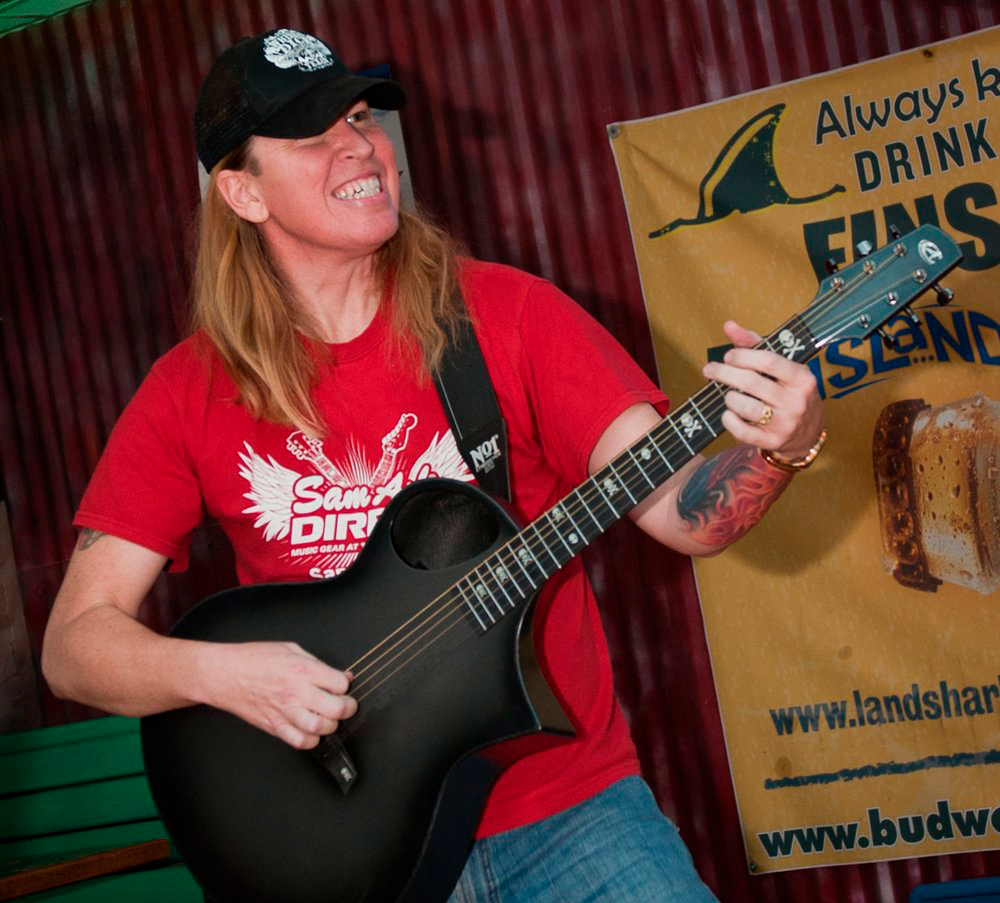
Hi everyone! I’m Thomas Moody, also known as Guitarzan.
